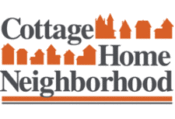Cottage Home Neighborhood is a NESCO community, bounded by 10th, Oriental, and Michigan Streets, and I-70. The neighborhood takes its name from the style of houses built here between 1870 and 1900. Early residents built modest frame cottage in a variety of styles, including shotgun and Queen Anne vernacular. Many of the cottages feature turned posts and spindles, gingerbread trim porches, brackets, and fish scale shingles.
Modest Frame Cottages Frederick Ruskaup House The one architectural exception is the brick residence at 711 Dorman St. , built for Frederick Ruskaup in 1892. Undoubtedly the gem of the neighborhood, this brick mansion stands out among the cluster of small frame cottages. Ruskaup, a German native, immigrated to the United States in 1869.
Designed by Vonnegut & Bohn Architects
Older neighborhood residents recalled that in the early 1870s he wanted to build his grocery and house in the newly formed Woodruff Place, but because that neighborhood was restricted to houses, he decided to build on the other side of the United States Arsenal (now Arsenal Technical High School). By 1875 he had constructed a two-story brick grocery at 717-19 Dorman St., where his family lived in an upstairs apartment. In 1885 he added on to his grocery store. In 1891 he hired Vonnegut & Bohn, young Indianapolis architects, to design his brick home at 711 Dorman St., as well as to rebuild his five rental doubles across the street.
Neighborhood Restoration in 1980’s
Many of the 19th-century residents of Cottage Home were German. A significant number of Irish and a smaller group of African-American families also lived in the area, which remained a working class neighborhood well into the 20th century. The nearby railroad provided employment, as did veneer and furniture factories on Dorman St., and a flour mill on Highland Ave. From the teens through the 1930s, many residents worked as trolley operators for the Highland Car Barns (now St. Clair Press) on the corner of Highland Ave. and St. Clair St. Others worked as carpenters, machinists, policemen, firemen, factory workers, and tradesmen.
Like many downtown neighborhoods, the area suffered a decline from the 1940s through the 1980s. Residents watched as dozens of homes were demolished for the highway a couple blocks west. The threat of the Highland-Dorman connector (a plan to widen the streets, now removed from the city planners’ books) and talk of making the area an industrial park did not give residents incentive to continue investing the their properties.
In the mid-1980s, the 150-home community experienced a restoration boom, then again in the early 2000’s. The neighborhood continues to improve and now includes some new homes with a modern, cottage-style architecture.
In 1984 the Cottage Home Neighborhood Association was formed. This association helps organize membership and fundraising activities, applies for monetary grants and rallies volunteers to help maintain and improve the neighborhood and its historic facade.
In 2008, the Indianapolis Historic Preservation Commission voted unanimously to approve the Cottage Home Conservation Plan . Plan details are available at the IHPC site. This plan has helped access guidelines for all new construction in the neighborhood, keeping the neighborhood closely aligned with its original history and character. A downloadable PDF of the plan can be found here: CH Conservation Plan
